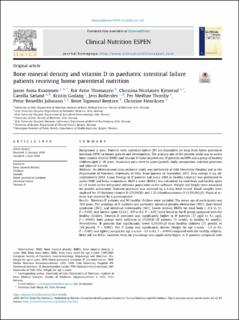| dc.description.abstract | Background & aims
Patients with intestinal failure (IF) are dependent on long-term home parenteral nutrition (HPN) to ensure growth and development. The primary aim of the present study was to assess bone mineral density (BMD) and vitamin D status in paediatric IF patients on HPN and a group of healthy children aged 2–18 years. Secondary aims were to assess growth, body composition, nutrient provision and physical activity.
Methods
An observational cross-sectional study was performed at Oslo University Hospital and at the Department of Nutrition, University of Oslo, from January to September 2017. Dual energy x-ray absorptiometry (DXA; Lunar Prodigy in IF patients and Lunar iDXA in healthy subjects) was performed to assess BMD and body composition. BMD z-score (BMDz) was calculated for total body and lumbar spine L2-L4 based on the integrated reference population in the software. Weight and height were measured for growth assessment. Nutrient provision was assessed by a 4-day food record. Blood samples were analysed for 25-hydroxy-vitamin D (25(OH)D) and 1,25-dihydroxyvitamin D (1,25(OH)2D). Physical activity was reported by a questionnaire.
Results
Nineteen IF patients and 50 healthy children were included. The mean age of participants was 10.0 years. The aetiology of IF patients was paediatric intestinal pseudo-obstruction (58%), short bowel syndrome (26%), and intestinal enteropathy (16%). Lower median BMDz for total body (−0.4 vs 1.1, P < 0.001) and lumbar spine L2-L4 (−0.9 vs 0.2, P = 0.01) were found in the IF group compared with the healthy children. Vitamin D provision was significantly higher in IF patients (17 μg/d vs 5.3 μg/d, P < 0.001). Both groups were sufficient in 25(OH)D (IF patients 71 nmol/L vs healthy 81 nmol/L). Nevertheless, IF patients had significantly lower 1,25(OH)2D than healthy children (71 pmol/L vs 138 pmol/L, P < 0.001). The IF group was significantly shorter (height for age z-score −1,5 vs 0,1, P = 0.001) and lighter (weight for age z-score −1,0 vs 0,1, P = 0.009) compared with the healthy subjects. BMIz did not differ; however, body fat percentage was significantly higher in IF patients compared with healthy children (34% vs 25%, P = 0.02). A lower frequency of physical activity was found in the IF group compared with the healthy group (P = 0.001).
Conclusions
Paediatric IF patients on HPN had lower BMD, impaired growth, and higher body fat percentage in comparison with the healthy children. Despite a higher total supply of vitamin D in the IF group, the levels of 25(OH)D did not differ. Nevertheless, a significantly lower level of 1,25(OH)2D was found in IF patients. The results raise questions regarding differences between oral and parenteral vitamin D provision and whether intestinal function is important for the metabolism of vitamin D. | en_US |

